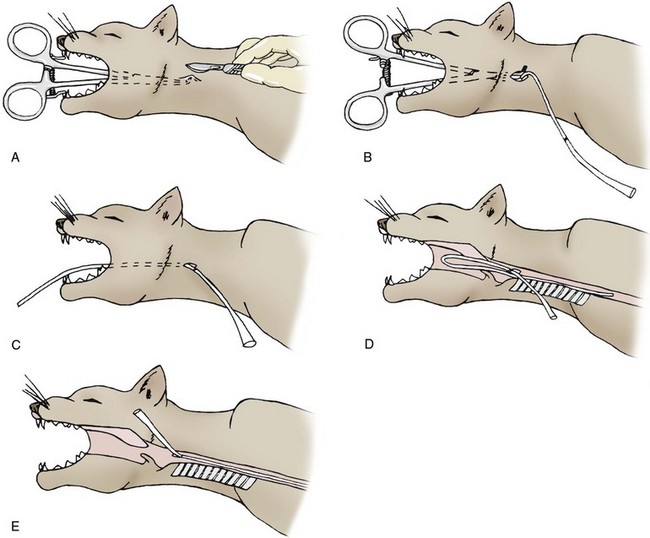cat feeding tube placement
Nasogastric feeding tube placement for cats. Nutrition is one of the most important considerations in the maintenance of health and early intervention can play a critical role in ensuring successful patient outcome and.
Esophageal feeding tubes are commonly used to provide enteral nutrition to cats but their use is associated with adverse effects.

. So to achieve a good outcome with a feeding tube it is important to make a sound plan. Cats that had an esophageal feeding tube placed n 248. Pass the tube to the predetermined distance.
The feeding tube should be pre-measured from the site of placement to the 7-8 th intercostal space. Here is a walkthrough on placin. The tube will generally drop into the oropharynx and stimulate a swallowing reflex.
In these cases placement of a naso-oesophageal feeding tube is an easy short-term option. The tube site where the tube exits the skin will need to be checked twice daily as well as some minor bandage care. These are surgically implanted in the throat and dump food into the esophagus allowing it to follow the normal path to the stomach.
Nasogastric feeding tube placement for cats. Each feeding takes around 20 minutes and cats are typically fed every 4-6 hours could be difficult to manage that time commitment. Esophageal feeding tubes are commonly used to provide enteral nutrition to cats but their use is associated with adverse effects.
An incision is made in the skin over the forceps such that the tip of the jaws can grip the feeding tube. This tube enters the esophagus the food pipe from a surgical incision on the left side of the neck. Typically the diet consists of a slurry consisting of a certain canned meal combined with a specific amount of water.
If a feeding tube has just been placed then a radiograph is typically taken to confirm its placement or equipment such as a capnograph could be used to check an NG or NO tube is not in the trachea Gray 2019. Uses Allows complete nutrition of debilitated animals or those who have sustained headjaw trauma. Placement Maintenance of Nasogastric Feeding Tubes in Cats.
Tube feeding was initiated anywhere from 2 to 144 hours after placement with a median of 12 hours in dogs and 14 hours in cats in our study. To evaluate the complications associated with e-tube placement in cats and to identify factors predisposing to these complications. Cats that had an esophageal feeding tube placed n 248.
Placement of an NG tube can be a way to support ill cats through a variety of disease states decreasing illness time hospitalization and are usually well-tolerated. The feeding tube is marked to length from the site of placement to the 7-8 th intercostal space A curved hemostat Kelly or Carmalt is introduced per os into the proximal esophagus. Placing an esophagostomy tube provides a route for feeding which avoids the oral cavity.
The amount type and delivery method of food through the NG tube will be presented. Tube may become dislodged and require expensive follow up visits to check and correct the placement. Spending extra time cuddling with your cat while youre feeding them can be a great bonding experience.
Elevate your cats front feet so that the food easily goes into the stomach. This is useful in animals with oral disease or those unable or unwilling to eat for other reasons. A curved hemostat Kelly or Carmalt should be introduced per os into the proximal esophagus.
Objectives To evaluate the complications associated with etube placement in cats and to identify factors predisposing to these complications. Complications occurred in 358 of the cats with the most common being tube dislodgement 145 followed by stoma site infections 121. A feeding tube is used to feed pets three to four times per day.
Pressure is applied to press the tip of the forceps against the skin caudal to the ramus of the mandible. Advantages Well-tolerated easy to site cheap. Gray 2019 also suggested aspirating from an NG tube to identify gastric juices is a useful method to check placement Figure 7.
For cats you can just use 40 weight in kg So Fifi a 35kg cat would require 140kcalday. Animals Cats that had an esophageal feeding tube placed n 248. Place the tube in the ventrolateral aspect of the external nares and pass it in a caudoventral medial direction into the nasal cavity.
This article outlines a practical systematic approach to the placement of feeding tubes a form of nutritional lifeline frequently utilised in small animal practice. The tube may be displaced and your pet needs to be brought to a veterinarian to check the placement of the tube. For cats a red rubber or silicone tube is used ranging from 10-14 French.
Replace the cap on the tube. Placing an esophagostomy tube provides a route for feeding which avoids the oral cavity. Esophageal E-tube tubes are the most common type of feeding tube used in cats.
Pressure is applied to press the tip of the forceps against the skin caudal to the ramus of the mandible.

How To Place An Esophagostomy Tube Vetgirl Veterinary Ce Podcasts

How To Place An Esophagostomy Tube Vetgirl Veterinary Ce Podcasts

Feeding Tube Placement Texas A M Veterinary Medical Teaching Hospital

Tube Feeding In Cats Vca Animal Hospital

How To Place An Esophagostomy Tube Vetgirl Veterinary Ce Podcasts

E Tube Placement Finger Trap Suturing In A Cat Youtube

The O Tube Why Do We Place Oesophagostomy Tubes In Cats Perth Cat Hospital

Feline Esophagostomy Feeding Tube Placement Youtube

Supportive Feeding Methods For Small Animals Today S Veterinary Nurse

Esophagostomy Tube Use In Cats Youtube

How To Place An Esophagostomy Tube Vetgirl Veterinary Ce Podcasts

Esophagostomy Tube Feeding In Cats Vca Animal Hospital
Esophagostomy Tube Information And Care

Gastrostomy Tube Feeding In Cats Vca Animal Hospital

How To Place An Esophagostomy Tube Vetgirl Veterinary Ce Podcasts

How To Place An Esophagostomy Tube Vetgirl Veterinary Ce Podcasts



